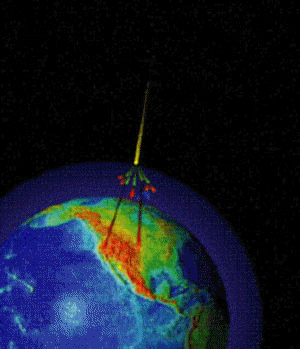 This
presentation explores cosmic rays, focusing mainly on the mysterious word of
ultra-high-energy cosmic rays. It is suitable for grades 11 and 12.
This
presentation explores cosmic rays, focusing mainly on the mysterious word of
ultra-high-energy cosmic rays. It is suitable for grades 11 and 12. This
presentation explores cosmic rays, focusing mainly on the mysterious word of
ultra-high-energy cosmic rays. It is suitable for grades 11 and 12.
This
presentation explores cosmic rays, focusing mainly on the mysterious word of
ultra-high-energy cosmic rays. It is suitable for grades 11 and 12.
We start with an overview of cosmic rays: what are these tiny visitors from space? This is where we introduce the star of the show, the ultra-high-energy cosmic ray, or UHE. Next we explore the different possible sources of UHEs, from black holes to colliding stars. Then we introduce our tools for learning more about UHEs, the detectors. Finally, a demonstration of a particular detector, one we call the ALTA-BC detector, is described very briefly (you really have to see it in person!)
The ALTA-BC experiment was chosen to anchor this presentation because it is being spearheaded by members of UBC Physics Outreach, and because it will involve highschools directly upon completion. Because of the difficulty in moving the module, classes were invited to come in to the Physics Outreach office to experience the demonstration. However, the wonder of cosmic rays can also be explored using a simpler scintillating photodetector and an oscilloscope, and so this presentation could be adjusted to be more portable.
Have a look at the ALTA-BC
page to get an overview of why the ALTA-BC experiment is so fascinating.
Introduction : What is a cosmic ray? : Where do UHE cosmic rays come from? : How can we detect UHEs? : The ALTA-BC module demonstration : Contact us to get a presentation at your school! : Back to the Phys 420 demo page